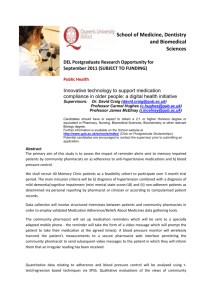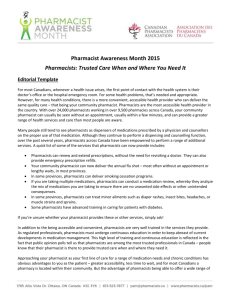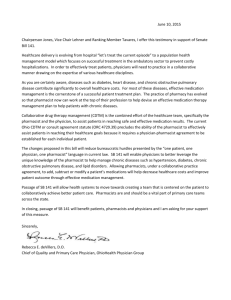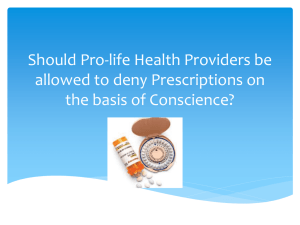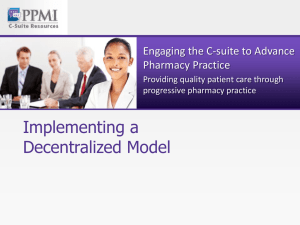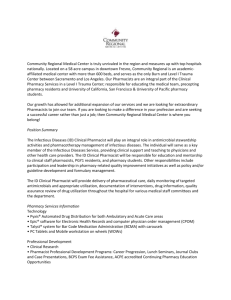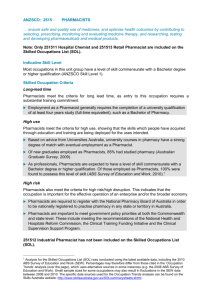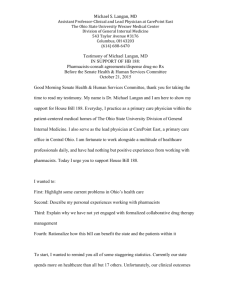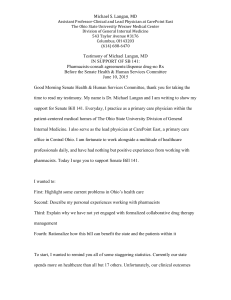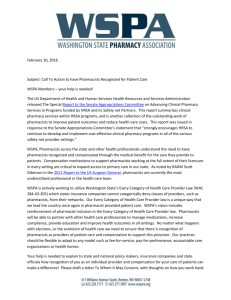Summary of return-on-investment research for pharmacist services
advertisement
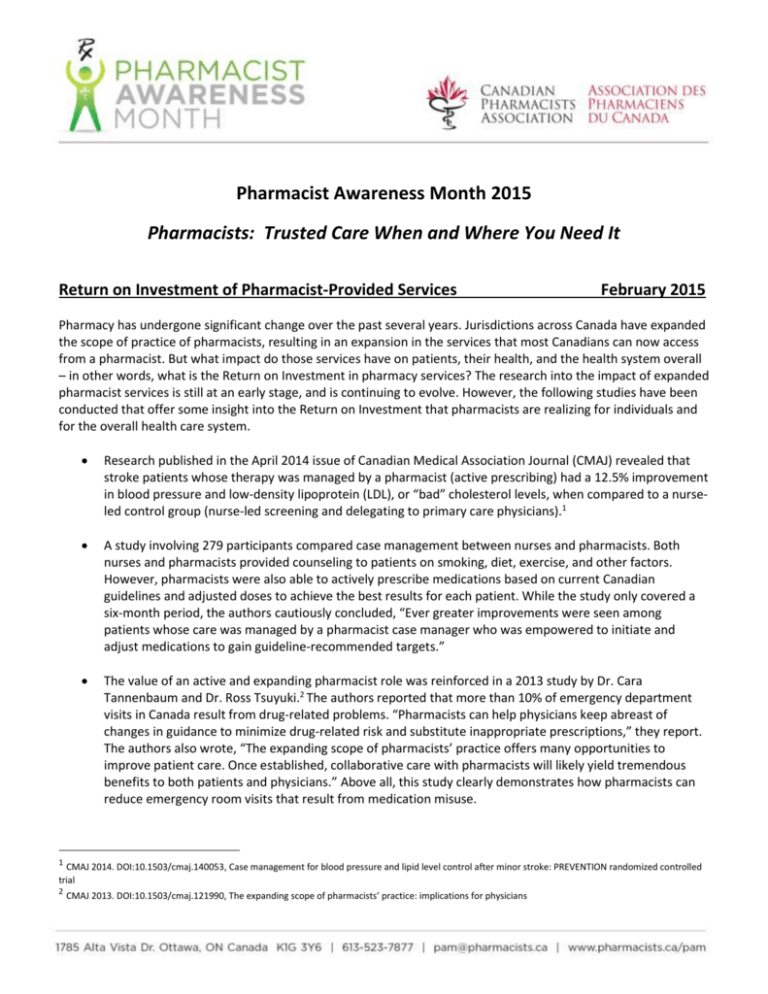
Pharmacist Awareness Month 2015 Pharmacists: Trusted Care When and Where You Need It Return on Investment of Pharmacist-Provided Services February 2015 Pharmacy has undergone significant change over the past several years. Jurisdictions across Canada have expanded the scope of practice of pharmacists, resulting in an expansion in the services that most Canadians can now access from a pharmacist. But what impact do those services have on patients, their health, and the health system overall – in other words, what is the Return on Investment in pharmacy services? The research into the impact of expanded pharmacist services is still at an early stage, and is continuing to evolve. However, the following studies have been conducted that offer some insight into the Return on Investment that pharmacists are realizing for individuals and for the overall health care system. Research published in the April 2014 issue of Canadian Medical Association Journal (CMAJ) revealed that stroke patients whose therapy was managed by a pharmacist (active prescribing) had a 12.5% improvement in blood pressure and low-density lipoprotein (LDL), or “bad” cholesterol levels, when compared to a nurseled control group (nurse-led screening and delegating to primary care physicians).1 A study involving 279 participants compared case management between nurses and pharmacists. Both nurses and pharmacists provided counseling to patients on smoking, diet, exercise, and other factors. However, pharmacists were also able to actively prescribe medications based on current Canadian guidelines and adjusted doses to achieve the best results for each patient. While the study only covered a six-month period, the authors cautiously concluded, “Ever greater improvements were seen among patients whose care was managed by a pharmacist case manager who was empowered to initiate and adjust medications to gain guideline-recommended targets.” The value of an active and expanding pharmacist role was reinforced in a 2013 study by Dr. Cara Tannenbaum and Dr. Ross Tsuyuki.2 The authors reported that more than 10% of emergency department visits in Canada result from drug-related problems. “Pharmacists can help physicians keep abreast of changes in guidance to minimize drug-related risk and substitute inappropriate prescriptions,” they report. The authors also wrote, “The expanding scope of pharmacists’ practice offers many opportunities to improve patient care. Once established, collaborative care with pharmacists will likely yield tremendous benefits to both patients and physicians.” Above all, this study clearly demonstrates how pharmacists can reduce emergency room visits that result from medication misuse. 1 CMAJ 2014. DOI:10.1503/cmaj.140053, Case management for blood pressure and lipid level control after minor stroke: PREVENTION randomized controlled trial 2 CMAJ 2013. DOI:10.1503/cmaj.121990, The expanding scope of pharmacists’ practice: implications for physicians A pilot study involving 27 pharmacies from across Nova Scotia was conducted in the spring and summer of 2013 following new regulations that enabled pharmacists to offer patients a minor ailment assessment and prescribing service. Over 1,000 patients participated in the study. Ninety-six percent of the patients who completed the satisfaction survey indicated that the service was beneficial or very beneficial, and 99% said they would use the service again. Patients particularly appreciated that the service was fast and convenient – and they valued the pharmacist’s knowledge and skills.3 For all employees, accessing advice and treatment options from pharmacists for minor ailments reduces absenteeism. The direct cost of absenteeism to the Canadian economy was $16.6 billion in 2012.4 Employees: o Don’t have to take time off work to seek treatment (as services are available through extended hours). o Can access treatment options more quickly. o Earlier intervention in any condition speeds recovery and helps reduce time away from work. Prompt intervention also reduces the possibility of complications of a more serious condition developing; requiring more expensive treatment options, additional time off work, or the possibility of short-term or long-term disability. Wellness services and the support of pharmacists can go a long way towards helping patients better manage their health and reduce their risk factors through prevention programs. Studies have shown that 80% of type 2 diabetes and heart disease cases and 40% of cancer cases are linked to lifestyle risk factors such poor nutrition, obesity, smoking, inactivity or alcohol consumption.5,6 Adherence to medication is a major contributor to complications for patients with chronic conditions. According to the World Health Organization, in developed countries only 50% of patients with chronic diseases adhere to treatment recommendations.7 The result is poor health outcomes and increased health care costs. However, the report also finds that improving adherence rates would provide a significant return on investment through prevention of risk factors and adverse health outcomes. 3 Evaluation of the Provision of Minor Ailment Services in the Pharmacy Setting Pilot Study, Final Report, October 2013, prepared for the Pharmacy Association of Nova Scotia (PANS) 4 Missing in Action, Absenteeism Trends in Canadian Organizations, Conference Board of Canada, Briefing September 2013, compliments of Sun Life Financial 5 Kenneth, “Keynote Presentation.” American College of Preventive Medicine Prevention 2008 Conference. Austin, Texas, 2008. 6 Loeppke, Ronald. “The Value of Health and the Power of Prevention.” International Journal of Workplace Health Management1, no. 2 (2008): 97. 7 Adherence to Long-Term Therapies, World Health Organization 2003


